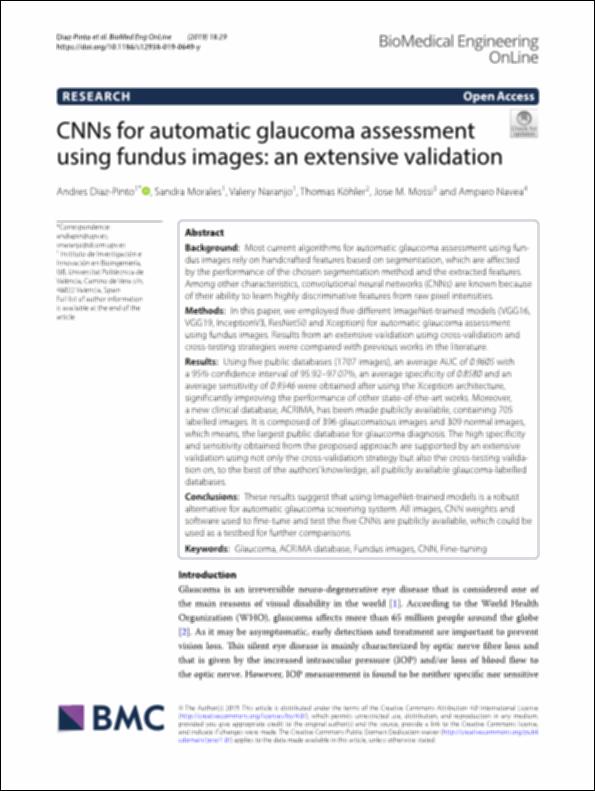Por favor, use este identificador para citar o enlazar este ítem:
http://hdl.handle.net/10637/10762CNNs for automatic glaucoma assessment using fundus images : an extensive validation
| Título : | CNNs for automatic glaucoma assessment using fundus images : an extensive validation |
| Autor : | Díaz Pinto, Andrés Morales Martínez, Sandra Naranjo Ornedo, Valeriana Köhler, Thomas Mossi García, José Manuel Navea Tejerina, Amparo |
| Materias: | Glaucoma - Bases de datos.; Ojos - Enfermedades - Diagnóstico por imagen.; Eye - Diseases - Imaging.; Glaucoma - Imaging.; Neural networks (Neurobiology); Glaucoma - Diagnóstico por imagen.; Glaucoma - Databases.; Redes neuronales (Neurobiología) |
| Editorial : | Springer Nature |
| Citación : | Diaz-Pinto, A., Morales, S., Naranjo, V., Köhler, T. Mossi, JM. and Navea, A. (2019). CNNs for automatic glaucoma assessment using fundus images : an extensive validation. BioMedical Engineering OnLine, vol. 18 (20 mar.), art. 29. DOI: https://doi.org/10.1186/s12938-019-0649-y |
| Resumen : | Background: Most current algorithms for automatic glaucoma assessment using fundus images rely on handcrafted features based on segmentation, which are affected by the performance of the chosen segmentation method and the extracted features. Among other characteristics, convolutional neural networks (CNNs) are known because of their ability to learn highly discriminative features from raw pixel intensities. Methods: In this paper, we employed five different ImageNet-trained models (VGG16, VGG19, InceptionV3, ResNet50 and Xception) for automatic glaucoma assessment using fundus images. Results from an extensive validation using cross-validation and cross-testing strategies were compared with previous works in the literature. Results: Using five public databases (1707 images), an average AUC of 0.9605 with a 95% confidence interval of 95.92–97.07%, an average specificity of 0.8580 and an average sensitivity of 0.9346 were obtained after using the Xception architecture, significantly improving the performance of other state-of-the-art works. Moreover, a new clinical database, ACRIMA, has been made publicly available, containing 705 labelled images. It is composed of 396 glaucomatous images and 309 normal images, which means, the largest public database for glaucoma diagnosis. The high specificity and sensitivity obtained from the proposed approach are supported by an extensive validation using not only the cross-validation strategy but also the cross-testing validation on, to the best of the authors’ knowledge, all publicly available glaucoma-labelled databases. Conclusions: These results suggest that using ImageNet-trained models is a robust alternative for automatic glaucoma screening system. All images, CNN weights and software used to fine-tune and test the five CNNs are publicly available, which could be used as a testbed for further comparisons. |
| Descripción : | Este artículo se ha publicado de forma definitiva en: https://biomedical-engineering-online.biomedcentral.com/articles/10.1186/s12938-019-0649-y En este artículo también participan: Sandra Morales, Valery Naranjo, Thomas Köhler, Jose M. Mossi and Amparo Navea. |
| URI : | http://hdl.handle.net/10637/10762 |
| Derechos: | http://creativecommons.org/licenses/by/4.0/deed.es |
| ISSN : | 1475-925X (Electrónico) |
| Fecha de publicación : | 20-mar-2019 |
| Centro : | Universidad Cardenal Herrera-CEU |
| Aparece en las colecciones: | Dpto. Medicina y Cirugía |
Los ítems de DSpace están protegidos por copyright, con todos los derechos reservados, a menos que se indique lo contrario.


